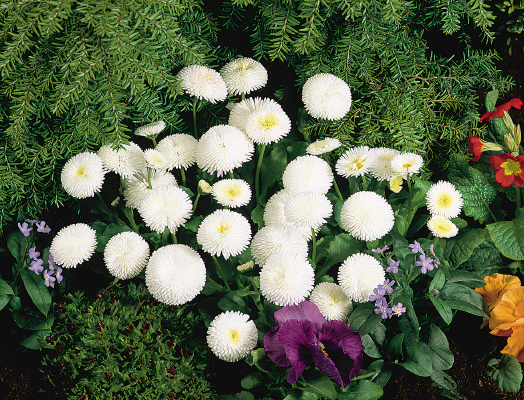

Tasso® White
Item no.: BP0505P- Compact pomponette type
- Medium-sized, fully double flowers
- Perfect for spring production
- Very attractive for pot and pack production
- Crop Time
- Spring: 20 - 22 weeks
- Height ∅
- 5 ″ / 13 cm
- Exposure
- Sun - Partial shade
- Seed Form
- Pelleted Seed
- Hardiness Zone
- 4b-8a
- Best Uses
- Bedding, Landscape, Pot Plant
Culture guide
Usage
Plants for landscape and borders, pot plants, plants for grave
Sow time
Pot plant production (frost free): End August - Mid September; Pot plant production (without heating): Mid August - End August
Sowing method
3-5 seeds per plug
Germination
7-14 days at 68 °F (20 °C), do not cover seed
Growing on
Transplant plugs in mid winter to mid spring. Plants will flower in approximately 8-10 weeks when grown 40-50 °F (5-10 °C), under similar conditions to spring pansies.
Media
Use a well-drained, growing substrate with 15-30 % clay, 0-15 % organic parts (e.g. compost), 1 kg/m³ complete balanced fertilizer, 0-2 kg/m³ slow release fertilizer (3-6 months), iron-chelate, micronutrients, pH: 5.5-6.2.
Temperature
Grow at 10-12 °C or outdoors. In winter indoors frost free at 3-5 °C or outdoors. Outdoor fleece cover needed. At mid December the plants start to grow for 5-7 weeks at 10-12 °C. Grow as cool as possible but avoid freezing temperatures for a good plant quality. Temperatures above 12 °C will result in big foliage growth, thin flower stems and missing flowering initiation. Temperatures below 6 °C delay the buds development. At warm outdoors temperatures open airing in time.
Fertilization
Moderate fertilization levels are required. Fertilize the crop weekly with 150-200 ppm nitrogen (at 0 kg/m³ slow release fertilizer in substrate), using a complete balanced fertilizer. The plants take up the minerals at 5 °C. Avoid high ammonium and high nitrogen levels. Don’t fertilize after early October. In spring fertilize 150-200 ppm nitrogen of a potassium balanced fertilizer (N: K₂O-ratio: 1:1,5). The roots are sensitive to high salt levels in substrates.
Stage I Starts with the radicle breaking through the testa. The roots are touching the medium. Ends with fully developed cotyledons.
Stage II Starts from fully developed cotyledons. Ends with the fully developed true leaf or true leaf pair.
Stage III Starts from the fully developed true leaf or true leaf pair and ends with 80% of the young plants being marketable.
Stage IV All young plants are ready for sale and in the process of being hardened off. This stage lasts about 7 days.
The cultural recommendations are based on results from trials conducted under Central European conditions. Different conditions in other parts of the world may lead to deviations in results achieved.




